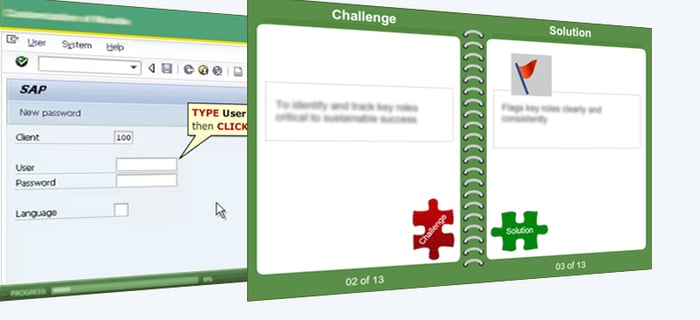Simple Ways to Convert ILT Courses to E-learning
This blog gives tips on converting ILT courses to e-learning.

A manufacturing firm wanted to convert its instructor-led compliance training program to an e-learning course. They converted their PowerPoint decks into an online course using Articulate Storyline with a full narration of the text in the PowerPoint slides. After a few months, they conducted an assessment and discovered the e-learning course was not effective and employees were not better informed about compliance. Where had they gone wrong? Apparently, the e-learning course did not engage learners and they were not getting anything valuable from it. So how does one effectively transform ILT courses into engaging online courses? This blog will give you the answer.

The objectives of ILT courses and e-learning are the same, to help learners acquire knowledge and skills, change their behavior, and improve performance outcomes. The content of both should be relevant and meaningful to learners. The goal of both these forms of learning is to make the experience meaningful, motivational, and appealing to learners. But the styles and methods adopted by instructors or course designers to achieve this are different, and this should be at the back of your mind when attempting a conversion. When text-heavy ILT courses are converted to e-learning modules, it makes teaching of complex concepts easier.
Successful conversion through appropriate strategies
The conversion of ILT courses into e-learning can be successful only if the learning strategies in ILT are replaced with appropriate strategies in e-learning courses that can achieve the same objective of engaging the learner. Let us see how in this example:

An IT company wanted to train its employees on a talent management tool and how the tool can be used to allocate resources. The company wanted to convert their ILT courses to e-learning courses to make the training available on a continual and cost effective basis to employees. The course was converted keeping these factors in mind:
(a) Repurposed the existing ILT content to engage the learner. The text-heavy ILT course was converted into e-learning with self-explanatory text and animations. Suitable images and appropriate audio were added wherever necessary to supplement the text. The content was analyzed and unnecessary information was removed and content tweaked to refine the course for e-learning.
(b) Redesigned the activities in the ILT course to fit the context, delivery platform and audience needs of an e-learning course. The written explanation on how to use the tool was converted to simulations in the e-learning course to help learners understand how to use the tool. The text-heavy ILT course was converted into engaging content using slideshows, tabs, sliders, definition boxes and related features.
Other conversion strategies
a. Text-heavy content can be converted to visuals in e-learning courses.
- Graphics, videos, animations and infographics should be used in the course wherever appropriate.
b. ILT learning strategies can be converted into interesting e-learning strategies.
- Case studies in ILT courses can be converted into ‘What-would-you-do’ scenarios to make learners think, instead of passively reading text on the screen.
- Problem solving exercises in ILT can be converted into scenarios. For instance, ILT courses have problem solving exercises involving small groups, in an e-learning course these can be reworked as real-life scenarios that present a problem similar to what the learners need to solve.
- Role plays can be converted to simulations in online learning.
You need to choose an appropriate authoring tool that will help you add interactivities in the online e-learning course.
Keep these facts in mind when converting ILT courses into online e-learning courses:
- Being text-heavy is a big no-no, instead shorten the text and present it interestingly.
- Decide what is the most important content by relating it to how far it will help learners in their job.
- Ensure logical flow of content.
- Courses need to be appealing to learners, use visuals and graphics.
- Visual elements and interactivities in the course should engage the learner much like the instructor in an ILT course.
- Use the right authoring tools
Hope you found the blog useful. Do share your views.





